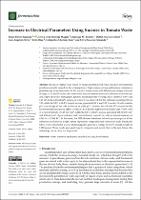| dc.contributor.author | Rojas-Flores, Segundo | |
| dc.contributor.author | De La Cruz-Noriega, Magaly | |
| dc.contributor.author | Benites, Santiago M. | |
| dc.contributor.author | Delfín-Narciso, Daniel | |
| dc.contributor.author | Angelats-Silva, Luis | |
| dc.contributor.author | Díaz, Felix | |
| dc.contributor.author | Cabanillas-Chirinos, Luis | |
| dc.contributor.author | Silva-Palacios, Fernanda | |
| dc.date.accessioned | 2023-09-20T22:01:53Z | |
| dc.date.available | 2023-09-20T22:01:53Z | |
| dc.date.issued | 2022-07 | |
| dc.identifier.uri | https://hdl.handle.net/20.500.13067/2592 | |
| dc.description.abstract | The use of organic waste as fuel for energy generation will reduce the great environmental problems currently caused by the consumption of fossil sources, giving agribusiness companies a profitable way to use their waste. In this research, tomato waste with different percentages of sucrose (0-target, 5, 10, and 20%) was used in microbial fuel cells manufactured on a laboratory scale with zinc and copper electrodes, managing to generate maximum peaks of voltage and a current of 1.08 V and 6.67 mA in the cell with 20% sucrose, in which it was observed that the optimum operating pH was 5.29, while the MFC with 0% (target) sucrose generated 0.91 V and 3.12 A on day 13 with a similar pH, even though all the cells worked in an acidic pH. Likewise, the cell with 20% sucrose had the lowest internal resistance (0.148541 ± 0.012361 KΩ) and the highest power density (224.77 mW/cm2) at a current density of 4.43 mA/cm2 , while the MFC with 0% sucrose generated 160.52 mW/cm2 and 4.38 mA/cm2 of power density and current density, respectively, with an internal resistance of 0.34116 ± 0.2914 KΩ. In this sense, the FTIR (Fourier-transform infrared spectroscopy) of all the substrates used showed a high content of phenolic compounds and carboxylate acids. Finally, the MFCs were connected in a series and managed to generate a voltage of 3.43 V, enough to light an LED (green). These results give great hope to companies and society that, in the near future, this technology can be taken to a larger scale. | es_PE |
| dc.format | application/pdf | es_PE |
| dc.language.iso | spa | es_PE |
| dc.publisher | MDPI | es_PE |
| dc.rights | info:eu-repo/semantics/openAccess | es_PE |
| dc.rights.uri | https://creativecommons.org/licenses/by/4.0/ | es_PE |
| dc.subject | Waste | es_PE |
| dc.subject | Tomatoes | es_PE |
| dc.subject | Saccharose | es_PE |
| dc.subject | Microbial fuel cells | es_PE |
| dc.subject | Bioelectricity | es_PE |
| dc.title | Increase in Electrical Parameters Using Sucrose in Tomato Waste | es_PE |
| dc.type | info:eu-repo/semantics/article | es_PE |
| dc.identifier.journal | Fermentation 2022 | es_PE |
| dc.identifier.doi | https://doi.org/10.3390/fermentation8070335 | |
| dc.subject.ocde | https://purl.org/pe-repo/ocde/ford#2.07.00 | es_PE |
| dc.source.volume | 8 | es_PE |
| dc.source.beginpage | 1 | es_PE |
| dc.source.endpage | 10 | es_PE |


